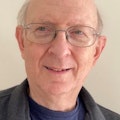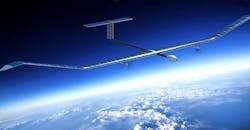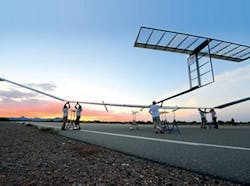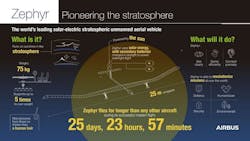Solar-Powered “Pseudo-Satellite” Aircraft Logs First Flight of 26 Days
Combining solar power plus rechargeable batteries, Airbus Defence and Space announced the successful premier flight of its first regular production model of the Zephyr S HAPS (High Altitude Pseudo-Satellite) (Fig. 1). It’s claimed to be a world record for longest duration flight for an unmanned aircraft without refueling. Taking off on July 11 from Arizona, the flight lasted 25 days, 23 hours, and 57 minutes, just a few minutes under 26 days, and demonstrated that a long-term mission is feasible for a solely solar-electric, stratospheric-level unmanned aerial vehicle (UAV) flying above the weather and conventional air traffic.
The Zephyr S HAPS. (Source: Airbus)
Zephyr is designed to offer capabilities that fill a gap and complement the roles filled by satellites, UAVs, and manned aircraft by providing long-term local satellite-like services. Applications include maritime surveillance and services, border patrol missions, communications, forest fire detection and monitoring, or navigation, often summarized as ISR (Intelligence, Surveillance & Reconnaissance).
The Zephyr, with the persistence of a satellite and the flexibility of a UAV, flies in the stratosphere at an average altitude of 21 km/70,000 feet. The ultra-lightweight weighs just 75 kg/165 pounds and has a wingspan of 25 meters/82 feet (Fig. 2). Payload is approximately 2.5 kg (5.5 lb.). The only civil aircraft to operate at this altitude was the supersonic Concorde, and the military U2 and SR-71 Blackbird reconnaissance aircraft. The powerplant consists of two custom permanent-magnet synchronous motors rated at 0.60 hp (0.45 kW) each.
(Source: Airbus via SAE)
Critical to the operation during nighttime periods (cloud cover isn’t an issue, of course) are the batteries, provided by Amprius Inc. Their silicon-anode technology was originally developed at Stanford University and uses silicon nanowires in the negative side of a lithium-ion battery instead of the conventional carbon. (For more details on this technology, see “Stanford Start-Up Amprius Aims to Mass Produce High-Energy Lithium Ion Batteries” in Scientific American.)
It’s known that using silicon here has the potential to increase battery density because one silicon atom can hold on to four lithium ions, while it takes six carbon atoms to hold just one lithium ion. However, there are major issues with swelling and fracturing of the silicon after a few charge/discharge cycles. Amprius claims to have overcome these with its technology, which offers specific energies of over 435 Wh/kg and energy densities in excess of 1200 Wh/liter. (Amprius won’t divulge its Zephyr-related battery-capacity and weight numbers due to their “proprietary nature.”)
This new record flight was supported by the UK government; the UK Ministry of Defence is the first customer for this aircraft.
Reference
Air Force Technology, ”Zephyr S High-Altitude Pseudo-Satellite (HAPS)”
About the Author

Bill Schweber
Contributing Editor
Bill Schweber is an electronics engineer who has written three textbooks on electronic communications systems, as well as hundreds of technical articles, opinion columns, and product features. In past roles, he worked as a technical website manager for multiple topic-specific sites for EE Times, as well as both the Executive Editor and Analog Editor at EDN.
At Analog Devices Inc., Bill was in marketing communications (public relations). As a result, he has been on both sides of the technical PR function, presenting company products, stories, and messages to the media and also as the recipient of these.
Prior to the MarCom role at Analog, Bill was associate editor of their respected technical journal and worked in their product marketing and applications engineering groups. Before those roles, he was at Instron Corp., doing hands-on analog- and power-circuit design and systems integration for materials-testing machine controls.
Bill has an MSEE (Univ. of Mass) and BSEE (Columbia Univ.), is a Registered Professional Engineer, and holds an Advanced Class amateur radio license. He has also planned, written, and presented online courses on a variety of engineering topics, including MOSFET basics, ADC selection, and driving LEDs.


